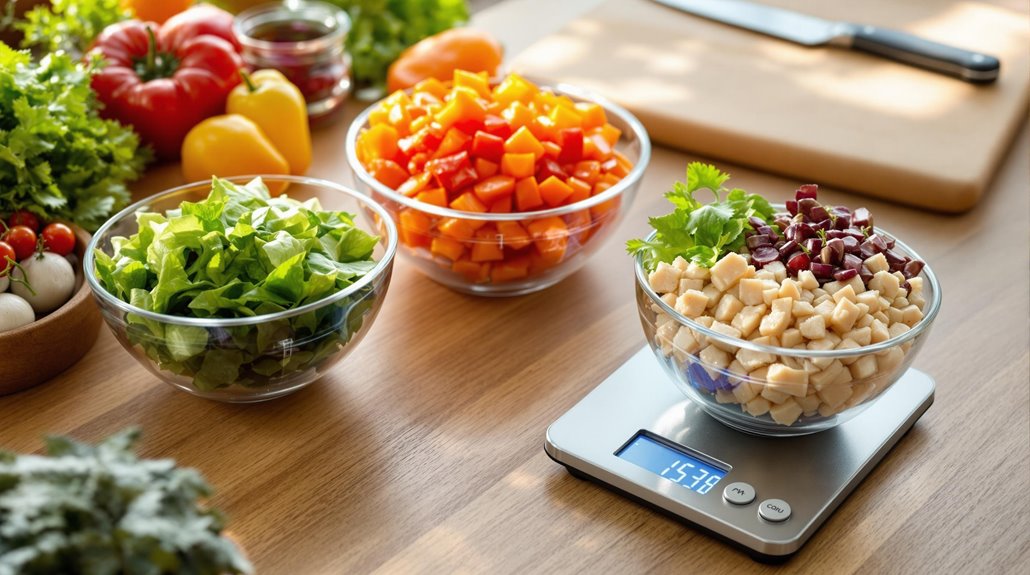
Mastering portion control is essential for balanced nutrition and healthy weight management. Start by distinguishing between standard serving sizes and personal portions. Use smaller plates and measure food with scales or cups. This helps in regulating intake and enhances mindful eating. Develop habits like eating slowly and refraining from distractions. When dining out, opt for half portions or appetizers, and drink water before meals to curb appetite. Try smaller beverage sizes and avoid buffets. Being mindful of diverse food groups also supports portion control. By knowing these strategies, you’ll uncover more benefits that promote a healthier lifestyle.
Defining Portion Control
Imagine effortlessly managing your food intake to support a balanced and healthy diet—this is the essence of portion control. By honing your portion awareness, you embrace the power to liberate yourself from unnecessary calories. It’s the art of recognizing the delicate relationship between food quantity and its impact on your health.
Embracing portion control means understanding that while serving sizes are standardized amounts reflecting nutritional values, your portion size is the amount you choose to consume. Water, which constitutes approximately 60% of the human body, plays a vital role in supporting a balanced diet by regulating body temperature and transporting nutrients. By choosing nutrient-dense foods, you can effectively manage your weight and promote overall wellness, as these foods are lower in calories yet provide essential nutrients.
In today’s world, where portion distortion tempts you with oversized meals, the significance of differentiating between serving sizes and portion sizes becomes paramount. Mastering this distinction helps you make conscious decisions every time you’re faced with a plateful of possibilities. You’re not just eating; you’re choosing freedom through moderation.
Portion control isn’t just about weight management—it’s a holistic approach to enhance digestion, control blood pressure, and stabilize blood sugar levels. By measuring or estimating proper serving sizes, you can tailor meal portions that suit your unique needs, avoiding overeating and promoting long-term wellness.
In doing so, you carve a path to sustaining a healthy lifestyle, empowering you to live freely and vibrantly on your terms.
Practical Strategies
A plate of food can look inviting, but mastering portion control requires intentional decisions beyond mere aesthetics. Choosing portion sizes is a mix of art and planning. Investing in scales or measuring cups aids in accurate food assessment, ensuring you stay mindful of how much you consume. When you’re at a restaurant, consider ordering a couple of appetizers or sides instead of a full entrée. This serves as a smart way to manage what you eat. Sharing meals or asking for a to-go box upfront can prevent overeating. Similarly, avoiding buffets is essential to keep your portion sizes in check, and always opt for small beverages. Suggest having extra items like bread baskets removed. For snacks, repackaging into individual portions can keep you from the mindless munch. Embrace single-serving options and steer clear of eating while multitasking. Instead, savor fresh produce for your snacking needs. Hydration plays a key role in weight management; aim to stay hydrated by drinking at least 11-12 glasses of water daily. Small containers work wonders to maintain control. Mindful eating habits involve paying attention to what you consume. Eat without distractions—focusing slowly on your food helps the brain recognize fullness. Visual cues like the plate method or using everyday objects to measure food sizes can also guide you:
| Strategy | Description | Action |
|---|---|---|
| Order Management | Choose sides over full meals | Opt for appetizers |
| Share Meals | Split meals or pack half | Share with a friend |
| Re-portion Snacks | Divide into serving portions | Use small containers |
| Eat Slowly | Pace your meal to recognize fullness | Chew deliberately |
| Visual Cues | Use objects to measure | Apply the plate method
Home Practices

Mastering portion control at home begins with mindful preparation and intentional choices. You can set yourself free from overeating by embracing smaller serveware. Switch to small plates and bowls to naturally limit portion sizes without feeling deprived. This simple swap changes the game by making portions look satisfying yet controlled.
Serving techniques play a pivotal role in managing how much you eat. Instead of placing large dishes on the table, serve meals directly on your plate. This way, you consciously decide the right portion size every time your hand reaches for another helping. Regular meal timing prevents overeating; set a timer to remind you to eat at consistent intervals, roughly every 3-4 hours, ensuring you manage your portions and maintain energy levels throughout the day.
Trust yourself to listen to your body’s signals by eating mindfully. Slow your pace, savoring each bite without distractions like TV. These moments of focus give your brain the time it needs to recognize when you’re satisfied. In fact, eating slowly helps the brain to better gauge fullness, which typically occurs after about fifteen minutes.
Free your kitchen from temptations by removing unnecessary extras. Freezing leftovers and packaging snacks in single servings help prevent overeating later.
Plan meals with portion sizes in mind, ensuring each plate is balanced and waste-free. Through these practices, you empower yourself to maintain control and achieve a healthier, liberated lifestyle right from your kitchen.
Dining Out Tips
While you’ve honed your portion control skills at home, extending these strategies to dining out can greatly aid in maintaining healthy habits. Start by recognizing that restaurant portion sizes are often double or triple what you need. To combat this, request half portions or consider ordering from the kids’ menu for a naturally small serving. Meal sharing is another liberating option. Splitting a main course with a friend not only halves your usual intake but enhances your dining experience by promoting connection and conversation.
To further manage portion sizes, view starters as your main dish since they’re typically more modest. A study by the NIH reveals that restaurant portion sizes are steadily increasing, which could lead to consuming nearly 1,600 extra calories daily. Alternatively, ask for a box upfront and have half your meal packaged away before you even begin. This simple trick guarantees you won’t be tempted by excess food. Consuming water before meals can also help to reduce hunger and prevent overeating.
Before eating, boost fullness by drinking a glass of water and starting with a salad tossed in vinegar or light dressing. Avoid buffets, which encourage overeating. Finally, refuse extra temptations like bread baskets or fries.
With these empowering dining out tips, you’ll remain in control, enjoying balanced meals without sacrificing the joy of eating out.
Benefits of Portion Management

Frequently, portion management provides significant health advantages that extend beyond mere weight control. By practicing caloric awareness and monitoring serving sizes, you can achieve and maintain a healthy weight, reducing the risk of obesity and its associated health issues.
This approach allows you to enjoy a balanced and varied diet without sacrificing your freedom to indulge occasionally. Focusing on portion management doesn’t just impact your weight; it also enhances your digestive health. By managing serving sizes, you can improve digestion, minimize the discomfort of overeating, and prevent issues like heartburn and bloating. This leads to better gut health and an overall sense of well-being.
Portion management guarantees you’re obtaining essential nutrients without overloading on any single food type. It encourages you to incorporate a variety of food groups such as fruits, vegetables, and whole grains, promoting a more nutritious diet. Additionally, using calorie tracking tools can enhance accountability in calorie consumption, helping you better manage your portion sizes and dietary choices.
This practice not only supports your energy levels but also boosts overall health, helping manage chronic diseases like diabetes and heart disease. Embrace the freedom of a healthy and active lifestyle by mastering portion control. You’ll not only enhance your meal experiences but also contribute positively to your longevity and wellness journey.
Balance With Mindful Choices
Mastering portion control involves a harmonious balance between mindful choices and practical strategies. By incorporating mindful eating principles, such as using smaller plates, savoring food, and eating without distractions, individuals can transform their relationship with food. These practices not only help to manage portion sizes effectively but also enhance the overall dining experience.
Engaging all the senses, taking small bites, and putting down utensils between bites are simple yet profound changes that encourage slower, more intentional eating and lead to greater satisfaction.
Mindful portion control offers numerous long-term benefits, including weight loss, improved glycemic control, and reduced emotional eating. By making a conscious effort to distinguish between physical and emotional hunger, individuals can make healthier food choices and enjoy meals without the stress of overeating.
Planning meals in advance and starting with nutrient-rich foods like soups and salads can set a strong foundation for balanced eating.
Ultimately, mindful portion control fosters self-awareness and self-control over one’s eating habits, promoting an overall healthier lifestyle. With time and practice, individuals will find themselves naturally gravitating towards smaller portion sizes and making more nutritious decisions, thereby reducing the frequency and severity of binge eating.














